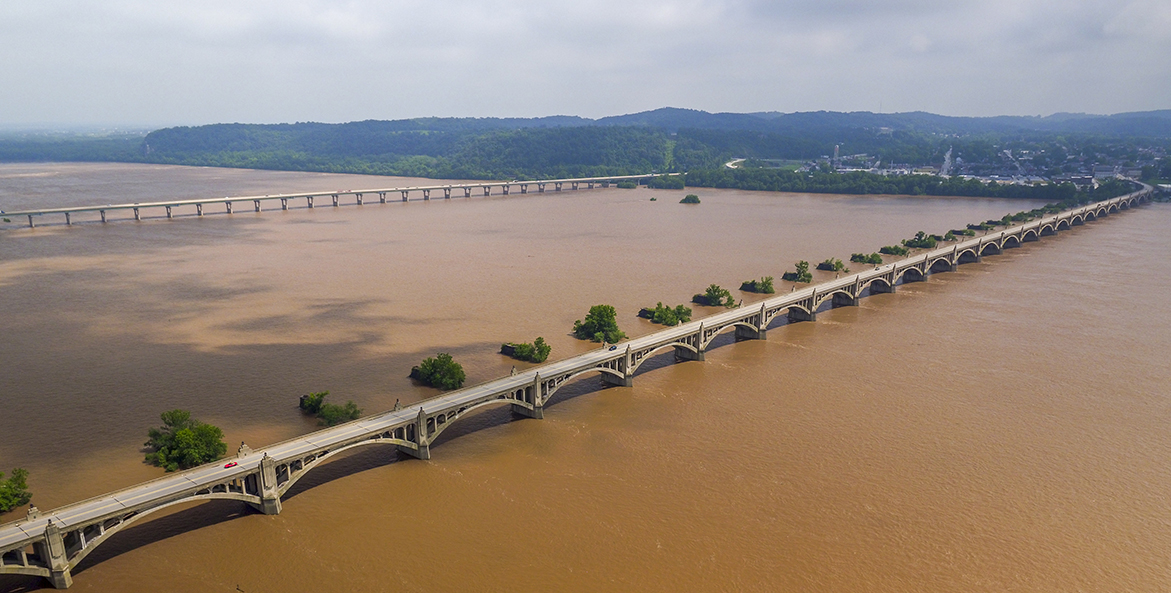When Category 4 Hurricane Ida blasted ashore in Louisiana earlier this week with 150 mph winds and torrential rains, many had questions about what the now tropical storm would mean for the Chesapeake Bay region.
The Susquehanna River drains the middle part of Pennsylvania and is the largest river feeding the Chesapeake, delivering, on average, half of the fresh water to the Bay. Heavy rains mean more runoff from the land, flooding, and more pollution into streams, rivers, and ultimately the Chesapeake Bay. Yesterday, as Ida swept across our region, Pennsylvania in particular saw one of its wettest days in history with average rainfall amounts falling between 4 and 7 inches. What's more, according to the United States Geological Survey (USGS), more than 200,000 cubic feet of water are currently passing through the Conowingo Dam, at the mouth of the Susquehanna, every second. That's 2.2 Olympic swimming pools of pollution-rich water entering the Bay every second. And that number is on the rise. For those who may be more familiar with a certain Maryland beer—that's 17.5 million 12 oz cans of Natty Boh every second.
We sat down with Beth McGee, CBF's Director of Science and Agricultural Policy, to understand more of what powerful storms like Ida mean for our region, and what we can expect in the future.
What are the biggest impacts we can expect from storms like Ida?
Localized flooding in Pennsylvania and elsewhere is certainly a concern for both human safety (e.g., loss of property or even life) and ecological (e.g., erosion of streambanks, smothering of fish and other aquatic organisms) reasons.
In terms of impacts on the Chesapeake Bay, timing is important.
- Late summer/early fall storms seem to have a lesser impact on dissolved oxygen compared to heavy rains in the early summer and spring. In addition, most underwater grasses have already started to die back, so effects will be lower, than say a storm that happens in May/June at the beginning of the growing season. That said, the high flows associated with heavy rains can scour and uproot bay grasses.
- Summer storms can mix the water column, shrinking the dead zone by mixing low/no oxygen bottom waters with well oxygenated surface waters.
- The greater amount of fresh water in the Bay could affect survival of oysters and clams, as well as distributions of fish and jellyfish
How does nutrient pollution, exacerbated by these storms, impact our water?
There are three main pollutants causing the poor health of our waterways—nitrogen, phosphorus, and sediment. Nitrogen and phosphorus are nutrients that we add to our grass, gardens, and cropland to make them grow. The problem is that excessive amounts of nitrogen and phosphorus fuel unnaturally high levels of algae growth in the water. When the algae die, they sink to the bottom and are decomposed by bacteria that consume the oxygen in the water. As a result, during the summer, large areas of the Bay and its rivers are plagued by "dead zones"—areas with insufficient oxygen to support aquatic life. Sediment (tiny particles of dirt floating in the water) turns the water cloudy, blocking sunlight from reaching aquatic grasses and smothering oysters and other bottom-dwelling species.
What about the Conowingo Dam?
The Conowingo Dam is located at the mouth of the Susquehanna River where it feeds into the Chesapeake Bay. Historically, the dam trapped a lot of sediment and associated nutrients. The dam is now full, so under higher flows, sediments and nutrients can be scoured from behind the dam, adding to the pollution loads coming from upstream. During storm events, "scour" contributes roughly a quarter of sediment pollution coming over the Conowingo Dam—the other three quarters are associated with storm flow. However, the bigger the storm, the greater the scour. In addition, lots of trash and debris that has been trapped behind the dam can also be scoured and end up on beaches downstream.
How does climate change play into all of this? And what can we do about it?
Climate change is predicted to increase the intensity and frequency of storms like Ida. It's important to keep in mind, however, that while heavy rains will always mean more pollution to our waterways, there are many things we can do to reduce runoff. Planting streamside forested buffers and wetlands will slow the flow of water and suck up nutrients and sediment. Farming practices like cover crops, no-till and rotational grazing lead to healthier soils that have a higher capacity to soak up rainwater. In our urban areas, more "green infrastructure" such as trees and rain gardens will similarly reduce runoff by allowing more rain to infiltrate back into the ground.





